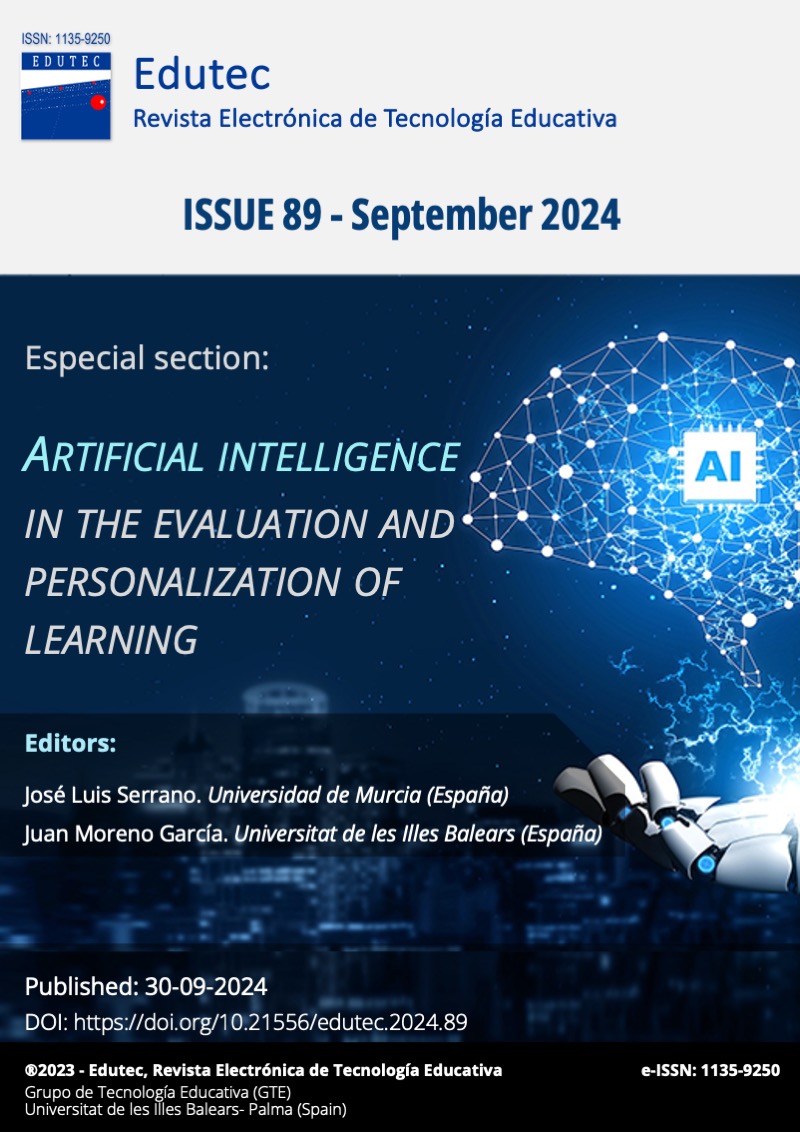AI Tutors vs. Human Instructors: Perceptions of Higher Education Students in Hungary and Spain
DOI:
https://doi.org/10.21556/edutec.2024.89.3523Keywords:
higher education, AI tutoring systems, Adaptive learning, Educational technology, Student perceptionsAbstract
Integrating AI-powered tutoring systems in higher education represents a significant advancement in educational technology, offering personalized and adaptive learning experiences. This study investigates the perceptions and expectations of higher education students in Hungary and Spain regarding AI tutors. Despite extensive research on the technological efficacy of AI systems, there is limited understanding of student attitudes in these specific cultural contexts. This research aims to fill this gap by exploring student expectations, satisfaction levels, and perceived benefits of AI tutors compared to human instructors. To achieve this, a validated questionnaire was administered to 184 higher education students from Hungary and Spain, capturing data on various dimensions of their expectations. The study's findings indicate that students appreciate the adaptability and continuous guidance provided by AI tutors, with Hungarian students showing higher overall expectations compared to their Spanish counterparts. These insights suggest that AI tutoring systems can enhance the learning experience by addressing individual student needs more effectively. The implications of this study are significant for higher education institutions seeking to integrate AI technologies.
Downloads
References
Allen, I. E., & Seaman, J. (2017). Digital learning compass: Distance education enrollment report 2017. Babson Survey Research Group.
Al-Shanfari, L., Abdullah, S., Fstnassi, T., & Al-Kharusi, S. (2023). Instructors’ perceptions of intelligent tutoring systems and their implications for studying computer programming in Omani higher education institutions. International Journal of Membrane Science and Technology, 10(2), 947-967. https://doi.org/10.15379/ijmst.v10i2.1395 DOI: https://doi.org/10.15379/ijmst.v10i2.1395
Basri, W. S. (2024). Effectiveness of AI-powered tutoring systems in enhancing learning outcomes. Eurasian Journal of Educational Research, 110, 33-52. 10.14689/ejer.2024.110.003
Byrne, B. M. (2001). Structural equation modeling with AMOS, EQS, and LISREL: Comparative approaches to testing for the factorial validity of a measuring instrument. International Journal of Testing, 1(1), 55-86. DOI: https://doi.org/10.1207/S15327574IJT0101_4
Carbonell, J. R. (1970). AI in CAI: An artificial-intelligence approach to computer-assisted instruction. IEEE Transactions on Man-Machine Systems, 11(4), 190-202. DOI: https://doi.org/10.1109/TMMS.1970.299942
Chan, C. (2023). A comprehensive AI policy education framework for higher education institutions. Journal of Educational Technology, 32(4), 215-230. https://doi.org/10.1080/10494820.2023.1963527
Chaudhry, M. A., & Kazim, E. (2022). Artificial Intelligence in Education (AIEd): A high-level academic and industry note 2021. AI and Ethics, 2(1), 157-165. https://doi.org/10.1007/s43681-021-00074-z DOI: https://doi.org/10.1007/s43681-021-00074-z
Chounta, I. A., Bardone, E., Raudsep, A., & Pedaste, M. (2022). Exploring teachers’ perceptions of artificial intelligence as a tool to support their practice in Estonian K-12 education. International Journal of Artificial Intelligence in Education, 32(3), 725-755. https://doi.org/10.1007/s40593-021-00243-5 DOI: https://doi.org/10.1007/s40593-021-00243-5
Cohen, J. (1988). Statistical power analysis for the behavioral sciences. Hillsdale, NJ: Erlbaum.
de Baker, R. S. J., & Inventado, P. S. (2014). Chapter X: Educational data mining and learning analytics. Comput. Sci, 7, 1-16. DOI: https://doi.org/10.1007/978-1-4614-3305-7_4
Dede, C. (2014). The Role of Digital Technologies in Deeper Learning. Students at the Center: Deeper Learning Research Series. Jobs for the Future.
Double Robotics. (2017). Double Robotics: Homebound students connect to classrooms. Retrieved from https://www.doublerobotics.com
Drasgow, F., Levine, M. V., Tsien, S., Williams, B. A., & Mead, A. D. (1995). Fitting polytomous item response models to multiple-choice tests. Applied Psychological Measurement, 19, 145-165. https://doi.org/10.1177/014662169501900203 DOI: https://doi.org/10.1177/014662169501900203
Edwards, A., Edwards, C., Spence, P. R., Harris, C., & Gambino, A. (2016). Robots in the classroom: Differences in students’ perceptions of credibility and learning between “teacher as robot” and “robot as teacher”. Computers in Human Behavior, 65, 627-634. https://doi.org/10.1016/j.chb.2016.06.005 DOI: https://doi.org/10.1016/j.chb.2016.06.005
Hajeer, A. (2024). Teaching ESP in the digital age: Implications for crafting effective course descriptions for online learning. Journal of Teaching English for Specific and Academic Purposes, 255–267. https://doi.org/10.22190/JTESAP231116021H DOI: https://doi.org/10.22190/JTESAP231116021H
Hajeer, A., Toptsi, J., & Horváth-Csikós, G. (2023). Validating the intercultural sensitivity scale in the Hungarian university context. Cultural Management: Science and Education, 7(2), 79-95. https://doi.org/10.30819/cmse.7-2.05 DOI: https://doi.org/10.30819/cmse.7-2.05
Hu, L., & Bentler, P. M. (1999). Cutoff criteria for fit indexes in covariance structure analysis: Conventional criteria versus new alternatives. Structural Equation Modeling, 6(1), 1-55. https://doi.org/10.1080/10705519909540118 DOI: https://doi.org/10.1080/10705519909540118
Kim, J., Merrill, K., Xu, K., & Sellnow, D. D. (2020). My teacher is a machine: Understanding students’ perceptions of AI teaching assistants in online education. International Journal of Human–Computer Interaction, 36(20), 1902-1911. https://doi.org/10.1080/10447318.2020.1801227 DOI: https://doi.org/10.1080/10447318.2020.1801227
Li, J. (2015). The benefit of being physically present: A survey of experimental works comparing copresent robots, telepresent robots and virtual agents. International Journal of Human-Computer Studies, 77, 23-37. https://doi.org/10.1016/j.ijhcs.2015.01.001 DOI: https://doi.org/10.1016/j.ijhcs.2015.01.001
Mitra, P. P. (2021). Fitting elephants in modern machine learning by statistically consistent interpolation. Nature Machine Intelligence, 3(5), 378-386. DOI: https://doi.org/10.1038/s42256-021-00345-8
Nguyen, A., Kremantzis, M., Essien, A., Petrounias, I., & Hosseini, S. (2024). Enhancing student engagement through artificial intelligence: Understanding the basics, opportunities, and challenges. Journal of University Teaching and Learning Practice, 21(6). https://doi.org/10.53761/caraaq92 DOI: https://doi.org/10.53761/caraaq92
Park, S., & Whang, M. (2022). Empathy in human–robot interaction: Designing for social robots. International journal of environmental research and public health, 19(3), 1889. https://doi.org/10.3390/ijerph19031889 DOI: https://doi.org/10.3390/ijerph19031889
Pfeifer, R., & Scheier, C. (1999). Understanding intelligence. MIT Press. DOI: https://doi.org/10.7551/mitpress/6979.001.0001
Woolf, B. (2009). Building intelligent interactive tutors: Student-centered strategies for revolutionizing e-learning. Morgan Kaufmann. DOI: https://doi.org/10.1016/B978-0-12-373594-2.00006-X
Downloads
Published
How to Cite
Issue
Section
License
Copyright (c) 2024 Edutec. Revista Electrónica de Tecnología Educativa

This work is licensed under a Creative Commons Attribution 4.0 International License.
By submitting the paper, the authors assign the publication rights to the journal Edutec. For its part, Edutec authorises its distribution as long as its content is not altered and its origin is indicated. At the end of each article published in Edutec, the citation procedure is indicated.
The management and editorial board of Edutec Revista Electrónica de Tecnología Educativa do not accept any responsibility for the statements and ideas expressed by the authors in their work.
Translated with www.DeepL.com/Translator (free version)









